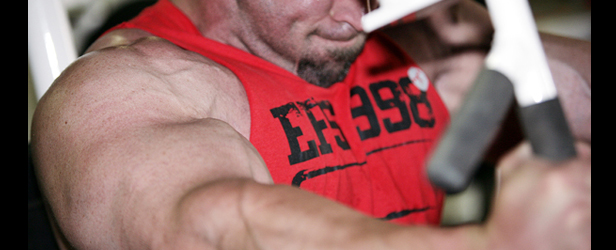
elitefts™ Sunday Edition
Is your goal is to move up to the prestigious night shift at Chippendales from your dreaded day shift? Wanting to look a little more dapper in your corporate sports coat? Looking to build a bigger and better physique? This trio of simple techniques can help make it happen!
Throw on Straps
For a bodybuilder, deadlifts serve to build the posterior chain. Barbell shrugs serve to build the traps. If your grip is the limiting factor in either of these exercises, wear straps. Obviously, you will want to build a strong grip, but not at the expense of sacrificing muscular development.
If an exercise has a limiting factor that sacrifices the work the muscle performs, eliminate this factor (in this example, wear straps) or find a new exercise.
This is why BOSU ball squats belong in a Coney Island side show, not as part of the serious muscle building process. The take-home point is simple: Let the muscles you are training limit the weight you use in training if hypertrophy is the desired result.
Decline Presses for Chest Development
Declines are a favorite for overloading the lower (sternal) portion of the chest. Like the incline or the flat bench, dumbbells can be used. Declines seem to be most effective at an angle of 20- to 25-degrees.
Many EMG studies now confirm declines work the entire chest!
Remember that the pectoral muscles perform two primary functions; flexion and adduction of your upper arm. Both of these happen during the upward phase of a decline bench. This why six-time Mr. Olympia Dorian Yates feels the decline bench is superior bodybuilding for chest development.
An added bonus is more weight can be handled, which means more muscle damage and more mechanical tension both stimulate hypertrophy.
Restricting Blood Flow
This study examined the effect of restricting blood flow to the upper arm muscles during a low intensity bench press regimen. Subjects were divided into a control group and a bloodflow restricted group. Both groups bench pressed 30 percent of their one-repetition max, twice daily, six days a week, for four weeks; the workout totaled 75 repetitions.
The blood flow restricted group bench pressed with elastic cuffs on both arms, and pressure increased progressively on both arms. The incremental increases in external compression started at 100 mmHg and ended at 160 mmHg.
Amazingly, the blood flow restricted group increased muscle thickness in triceps by eight percent. The pectoralis major muscles increased by sixteen percent. Interestingly, the muscle thickness of the control group stayed the same.
How this could apply to you?
Both groups in this study were novices. Barring injury, no one seriously trains with 30 percent of his one-repetition max to ignite muscle gains. Injury is where this study is potentially applicable.
When novices start to train, initial strength gains are neural, meaning they get better at the movement. Strength gains, because of increased muscle mass, take much longer.
By restricting blood flow to the upper arms with light weight, the injured bench presser may be better able to hold on to his bench press limit strength and his hard-earned muscle hypertrophy.
This all sounds great on paper. Hopefully soon, a similar study will be performed on healthy elite bench pressers with maximal weights.
References
Yasuda, T., Fujita, S., Ogasawara, R., Sato, Y., & Abe, T. (2010). Effects of low-intensity bench press training with restricted arm muscle blood flow on chest muscle hypertrophy: a pilot study. Clinical Physiology & Functional Imaging, 30(5), 338-343.









